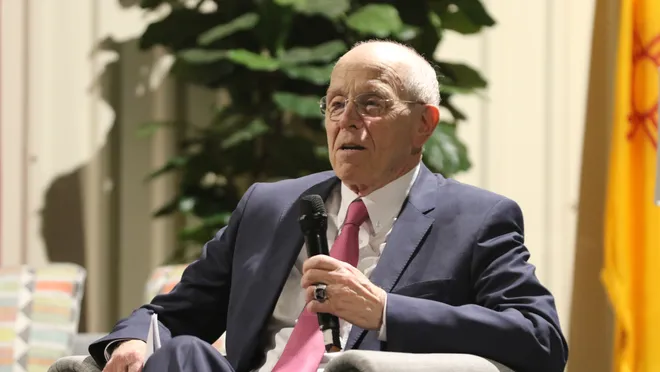 Restaurants and bars had the unfortunate role of being on the offensive line for most of 2020. Like blitzing linebackers, the impacts from the pandemic seemed to crash into them first: Shelter-in-place orders, capacity restrictions, mask mandates, reopenings all battered the fickle and fragile industry.
Restaurants and bars had the unfortunate role of being on the offensive line for most of 2020. Like blitzing linebackers, the impacts from the pandemic seemed to crash into them first: Shelter-in-place orders, capacity restrictions, mask mandates, reopenings all battered the fickle and fragile industry.
Most local restaurants took their licks and endured. Loyal customers showed up to support their regular spots, and restaurants became creative with takeout, sold booze to go and created meal kits with a bonus roll of toilet paper.
Then not long after the COVID-19 vaccine became available early in 2021 — and through this summer’s surge in cases — the local dining scene roared back to life. We threw off the weighted blanket of the pandemic determined to make up for lost time.
In May, Texans broke a monthly record for the amount of booze consumed at bars and restaurants. Sales for beer, wine and alcohol in the state totaled $738 million in May, almost twice the $400 million in February, during the winter storm and deep in the grips of the pandemic.
Parking lots are packed, entertainment districts like Deep Ellum and the Bishop Arts District are lively. Toilet paper is back in stock. Cheers.
But it’s not all tequila shots and bowls of queso. Heading into 2022, restaurants have shifted from recovery to reinvention in the choppy wake of the past two years. In addition to ongoing labor shortages, which might be the new norm, rising prices for goods are squeezing thin profit margins. A massive snarl in global logistics is holding basic items hostage. Plus, there’s a nasty new little habit diners have adopted post-COVID: no-showing on reservations.
While all these things won’t break the restaurant industry, it might take all of us to patch it back together.
Staffing Shortages
“Hiring is extremely difficult, as it is for everyone at this time,” says Brandy Spence, director of food and beverage for The Village, which includes Meridian, a high-end dining spot recently opened with chef Junior Borges leading the kitchen.
Her biggest source of referrals is an extensive list of contacts accumulated after years in the local restaurant business. Even with that, finding servers with fine-dining experience is a challenge. “You have to have a very good wine knowledge; it’s a high-end situation. You have to know the ingredients,” she says.
Will Call in Deep Ellum is experiencing the same problem. “Short-staffed is something everyone is going through right now. More so back-of-house, it seems. We’re fortunate enough to have most of the staff come back,” owner J.R. Muñoz says.
In a recent survey by the National Restaurant Association, 75% of restaurant operators identify recruitment and retention as their toughest challenge. Service industry workers who were out of a job in early 2020 are M.I.A. today. More than 300,000 have yet to return to the Texas restaurant labor force since before the pandemic. The tight labor market has driven up pay, which perhaps was due anyway, but is another increased cost for restaurants.
The association reports that hourly wages for restaurant workers are rising at a pace more than double the rate in the overall private sector. Even with guaranteed minimums of $15 an hour for dishwashing jobs, people are still sitting on the sidelines or have found new jobs.
Credit Suisse analyst Lauren Silberman told Bloomberg that the biggest headwind for restaurants is the availability of labor, “That’s all weighing on margins.”
While restaurant sales are up almost 20% across the nation compared with this time last year, wholesale food costs are increasing at the fastest rate in seven years, according to the restaurant association. The price of beef is up 41% over the same time last year; pork is up 33% and chicken 28%. Because of that, menu prices are being nudged up, but just by 4%.
Muñoz at Will Call said the prices of chicken wings have risen so much that his food rep actually tried to talk him into buying something else, “It makes it tough for us, because we’re so well known for wings.”
Basic supplies like to-go containers and cups are either hard to get or cost more. The snarl of shipping caused by the pandemic isn’t expected to clear up until next year at the earliest.
As for those high prices, ‘transitory inflation’ is the economic buzzword: the idea that price increases are only temporary due to shipping obstacles. Once those are correct, prices will coo. some think, but no one knows when or if that will happen.
So, staffing is difficult, the cost of labor is up, supplies are not always available, food costs more.
Several employees at a restaurant downtown were chatting recently. ESPN hummed in the background. A lady in stilettos and a dress worked on a glass of chilled white wine at the corner of the bar while a guy with his hair pulled back in a small bun finished lunch.
“No-shows on reservations for parties of 12 on a Saturday night are killing us right now,” one of the employees said to another. It was overheard, not intended for reporters’ ears, hence the anonymity.
Other than us three at the bar, there was only one other table occupied in the casually posh restaurant. The full lunch crowd still isn’t back downtown, which makes one wonder how many people trickle into the Central Business District for dinner during the week. This must be why this manager is stressed about reservations on the weekend.
Graham Dodds over at Elm and Good on the edge of Deep Ellum said one Saturday his restaurant had more than 70 canceled reservations in just one night. He’s dumbfounded by it. “It affects the entire crew,” he said, exasperated, as staffing decisions are made, in part, based on reservations.
“We have one person who has made 28 reservations and has dined with us four times,” Spence says of Meridian. She said they’ve had up to 100 cancellations in one night.
Michael Siegel is the food and beverage director for Headington Companies, which oversees CBD Provisions and The Midnight Rambler. “Last-minute cancellations and especially no-shows can greatly impact a server’s earning ability, as well as inhibit other diners from securing a table. Something as seemingly simple as not notifying the restaurant about a change to the reservation has ripple effects on many levels, particularly at a time when stability is so important.”
OpenTable, a major conduit to reservations, sent out a SOS in June. “Show Up for Restaurants” was an initiative aimed at highlighting the effect no-shows have on restaurants.
It’s not that they don’t try to mitigate no-shows from the outset; the website’s reservations system doesn’t allow users to book multiple tables for the same day and time. They, as well as Resy.com, send out reminders for reservations. Restaurants can step in and ask for a confirmation through text or phone calls, a practice Meridian has taken up.
“At a time when restaurants are facing staff shortages and more financial pressure than ever, they count on every diner that made a reservation to show up. When they don’t, restaurants could lose their entire profit margin for that shift,” OpenTable stated in a release.
When asked about requiring a downpayment for reservations, like Lucia does ($50 to reserve a table), Dodds at Elm and Good said they’ve considered many options, but only a few restaurants can get away with that tactic. Lucia, with a months’ long wait for a reservation and a fairly small dining room, can.
The average profit margin of a restaurant is between 3% and 5%, according to OpenTable, so it only takes a few no-shows to wipe out a restaurant’s profits. Using Blackfish in Philadelphia as an example, OpenTable said if six people don’t show up for one dinner, Blackfish loses 5% of its income, which is most of its profit margin.
OpenTable launched a new tool this summer to discourage no-shows; it allows restaurateurs to tag a diner as a potential no-show based on previous reservation activity, creating a two-way rating relationship similar to those between Uber or Airbnb and their customers.
click to enlarge At places like Will Call in Deep Ellum, they’re not only struggling with staffing but also with luring diners in during the week. – ALISON MCLEAN
At places like Will Call in Deep Ellum, they’re not only struggling with staffing but also with luring diners in during the week.
How can diners shift their habits to accommodate all of these issues? Muñoz paused to think about the answer. “That’s kind of a tough question. Restaurants are supposed to help you. Understanding would be the best help. Understanding why the cost has gone up at your favorite places because of the rise of shortages in every category across the board.”
Leslie Brenner, who now works as a restaurant consultant after spending eight years as the restaurant critic for The Dallas Morning News, says the customers have a role to play in ensuring their favorite restaurants make it through the post-pandemic rough patch.
“There’s employers, the staff and then the public, so three big pieces in all of this. What’s interesting is that the public was in danger of losing its beloved restaurants during the pandemic. And you’d think they would be better customers after,” Brenner says.
Restaurants sell more than the food on diners’ plates. Their product also is hospitality, a shared experience between the restaurants and their customers.
“Diners need to treat their experience at restaurants as hospitality,” she says. “Understand that this is a difficult labor model. (…) Don’t punish your server for some perceived slight or a backed-up kitchen. Try to be kind.”
Being patient with overtaxed servers, accepting that restaurants can’t control the supply chain and simply honoring reservations are all contributions diners can make to help the struggling industry. They should also reconsider which days they make those reservations. Show up on Tuesday, instead of just Friday and Saturday nights.
“Every day matters,” Muñoz says. “But, yes, know that during the week we’re just hoping and praying. And then doing the same thing on the weekend because during the week was so bad.”
Brenner is more to the point. “Your favorite restaurants are in danger of disappearing if you don’t show up, or if you only show up on a Friday and Saturday night. If you only show up on Friday and Saturday nights, then you’re only going to be able to go out on Friday and Saturday night.”
Muñoz is quick to point out that his neighborhood of Deep Ellum kept them afloat since the pandemic. Their regulars have stepped up and supported them. He’s still hoping to get enough seats filled to take some of the pressure off weekends.
Lucky for him, they don’t take reservations.




0 Comments